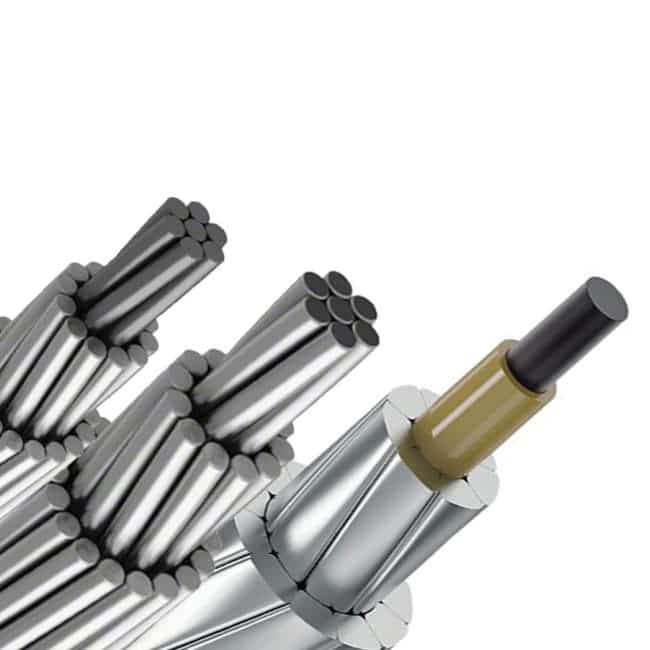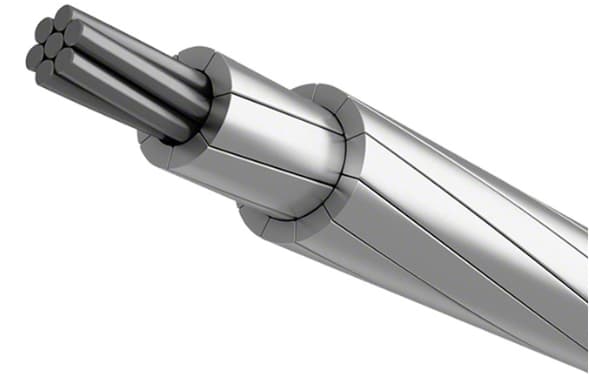HTLS 導体
High Temperature Low Sag Conductors (HTLS導体ケーブル) are designed to operate at temperatures as high as 250°C, enabling them to carry greater electrical loads than traditional conductors.
HTLS Conductor are particularly useful in situations where existing overhead lines face clearance issues and are limited in their current-carrying capacity, thereby preventing the installation of taller or newer towers.
HTLS conductors offer a solution by increasing ampacity without requiring extensive modifications to the majority of existing towers.
HTLS Conductor inculding ACCC Conductor, ACSS Conductor, ACSS/TW, ACSS/AW, Invar Conductor-TACIR and ZTACIR, GAP Type Conductor – GTACSR y GZTACSR, Heat Resistant Conductor – TACSR/AW.
HTLS Conductor Conductor
ACCCの指揮者
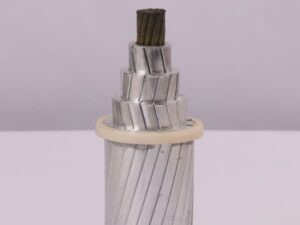
アルミニウム導体複合コア,ACCC Conductor is a type of conductor made by stranding annealed 1350-O aluminum wires in a trapezoidal shape around a lightweight core composed of carbon-glass fiber composite materials.
The ACCC Aluminum Conductor Composite Core offers superior strength and lighter weight compared to conventional steel-core conductors. Designed for continuous operation at temperatures up to 180°C, ACCC can carry twice the current of traditional ACSR conductors. Its lightweight core enables the use of approximately 30% more aluminum without increasing overall weight.
ACCC reduces line losses by 30 に 40% under equal load conditions compared to traditional ACSR conductors of similar diameter and weight. Its enhanced strength, effective self-damping properties, superior fatigue resistance, and low coefficient of thermal expansion minimize conductor sag under heavy electrical loads, allowing for increased spans between fewer or shorter support structures. さらに, ACCC conductors exhibit greater corrosion resistance compared to traditional ACSR conductors.
ACSS Conductor and ACSS/TW Conductor
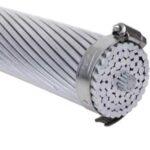
ACSS Conductor,Aluminum Conductor Aluminum-Clad Steel Supported (ACSS/AW) consists of one or more layers of annealed aluminum 1350-O wires stranded over a central core of aluminum clad steel wires that is designed to withstand most or all of the mechanical load onl ACSS/AW. ACSS/AW conductors are manufactured according to ASTM B 856, other standards could be offered.
ACSS/AW can operate continuously at high temperatures up to 200°C without damage. The aluminum clad steel core, which consists of a thick layer of aluminum (approx. 10% of the nominal wire radius) over steel, gives AcSS/AW conductors the advantages of standard ACSS along with light weight and good conductivity of aluminum with the high tensile strength and ruggedness of steel.
Invar Conductor-TACIR and ZTACIR
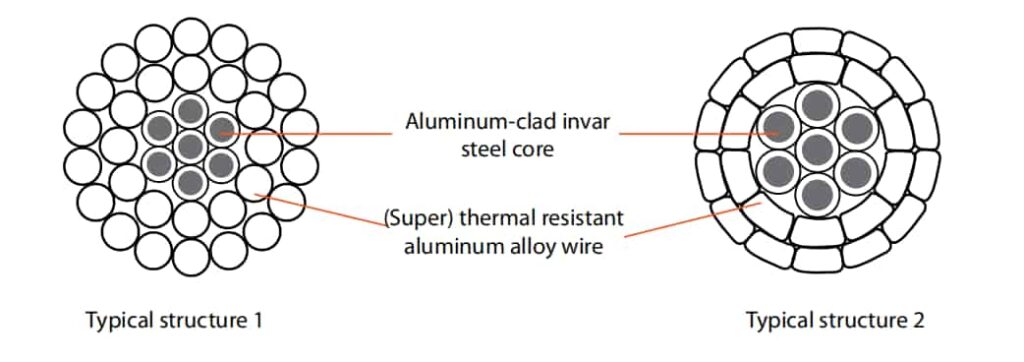
Invar conductor is composed of aluminumclad invar core and thermal-resistant aluminum alloy wires. This conductor is suitable for old line modification. It can keep the same sag while increasing capacity.
Invar Conductor is a nickel-iron alloy known for its low coefficient of thermal expansion, which means it expands and contracts minimally with changes in temperature. This property makes INVAR conductors particularly suitable for applications where temperature changes could cause significant expansion or contraction of the conductor.
Invar conductors are used in situations where maintaining a consistent conductor length under varying temperatures is crucial. This stability helps to minimize sag in overhead transmission lines, which can affect their efficiency and safety. The use of INVAR conductors is aimed at ensuring reliable power transmission by reducing the need for frequent adjustments due to thermal expansion and contraction.
HTLS Conductor Current Carrying Capacity

HTLS 導体 (High Temperature Low Sag) are designed to carry higher currents compared to traditional conductors like ACSR (アルミニウム導体鋼強化). The current carrying capacity of HTLS conductors depends on several factors including their design, operating temperature, and the specific application conditions. Here are some general characteristics and benefits related to their current carrying capacity:
Higher Operating Temperature: HTLS conductors are capable of operating at temperatures up to 250°C or higher. This elevated temperature capability allows them to carry more current without overheating compared to traditional conductors.
Enhanced Ampacity: Due to their design and material properties, HTLS conductors can typically carry about twice the current of similar-sized traditional ACSR conductors. This increased ampacity helps in optimizing the power transmission capacity of existing overhead lines without the need for extensive modifications.
Efficiency and Reliability: By carrying higher currents, HTLS conductors reduce resistive losses (I²R losses) in the transmission line. This results in improved efficiency and reliability of the electrical grid, as more power can be transmitted with less energy loss.
Flexibility in Transmission: HTLS conductors offer flexibility in upgrading existing transmission lines to handle higher power demands. They can be particularly advantageous in congested urban areas or regions where building new transmission infrastructure is challenging or costly.
Overall, HTLS conductors contribute to enhancing the efficiency, 信頼性, and capacity of electrical transmission systems by leveraging their higher current carrying capacity and temperature resilience.
HTLS Conductor Specification and HTLS Conductor Types
HTLS Conductor Specifications:
HTLS (High Temperature Low Sag) conductors typically have the following specifications:
Operating Temperature: They are designed to withstand high operating temperatures, usually up to 250°C or higher, which allows them to carry more current without overheating.
Materials: HTLS conductors often feature advanced materials such as high-strength aluminum alloys for the conductive strands and lightweight composite materials for the core. These materials help to reduce weight and increase mechanical strength.
デザイン: The conductors are engineered with a specific geometry and construction that minimizes electrical resistance (low loss) and enhances current carrying capacity (high ampacity).
Sag Performance: They are designed to have low sag under heavy electrical load conditions, which allows for longer spans between support structures and reduces the need for additional towers.
耐食性: HTLS conductors typically exhibit good resistance to corrosion, ensuring longevity and reliability in various environmental conditions.
HTLS Conductor Types:
There are several types of HTLS conductors, each designed for specific applications and performance requirements.
HTLS Conductor Size and HTLS Conductor Price
HTLS Conductor Size:
HTLS (High Temperature Low Sag) conductors are available in various sizes and configurations to meet different voltage and current carrying requirements in electrical transmission systems. The size of HTLS conductors is typically specified by their cross-sectional area, which determines their ampacity (current carrying capacity), mechanical strength, and overall performance. Here are some common sizes and specifications:
Cross-Sectional Area: HTLS conductors can range in cross-sectional area from a few hundred square millimeters up to several thousand square millimeters. The larger the cross-sectional area, the higher the ampacity of the conductor.
定格電圧: HTLS conductors are designed for different voltage ratings depending on the specific application and requirements of the transmission line. They can be used for both high-voltage (HV) and extra-high-voltage (EHV) transmission lines.
Stranding and Construction: The conductors are typically made up of multiple aluminum or aluminum alloy wires stranded together, often in a compact or semi-compact configuration. The construction and stranding pattern influence mechanical strength, flexibility, and resistance to vibration and wind-induced aeolian vibrations.
Weight and Diameter: HTLS conductors are engineered to be lightweight compared to traditional conductors like ACSR (アルミニウム導体鋼強化), which helps reduce the load on support structures and lowers installation costs.
HTLS Conductor Price:
The price of HTLS (High Temperature Low Sag) conductors can vary widely depending on several factors
The size of HTLS conductors refers to their cross-sectional area and configuration, which determines their electrical and mechanical performance characteristics. The price of HTLS conductors varies based on factors such as size, type, manufacturer, market dynamics, and project-specific considerations.

